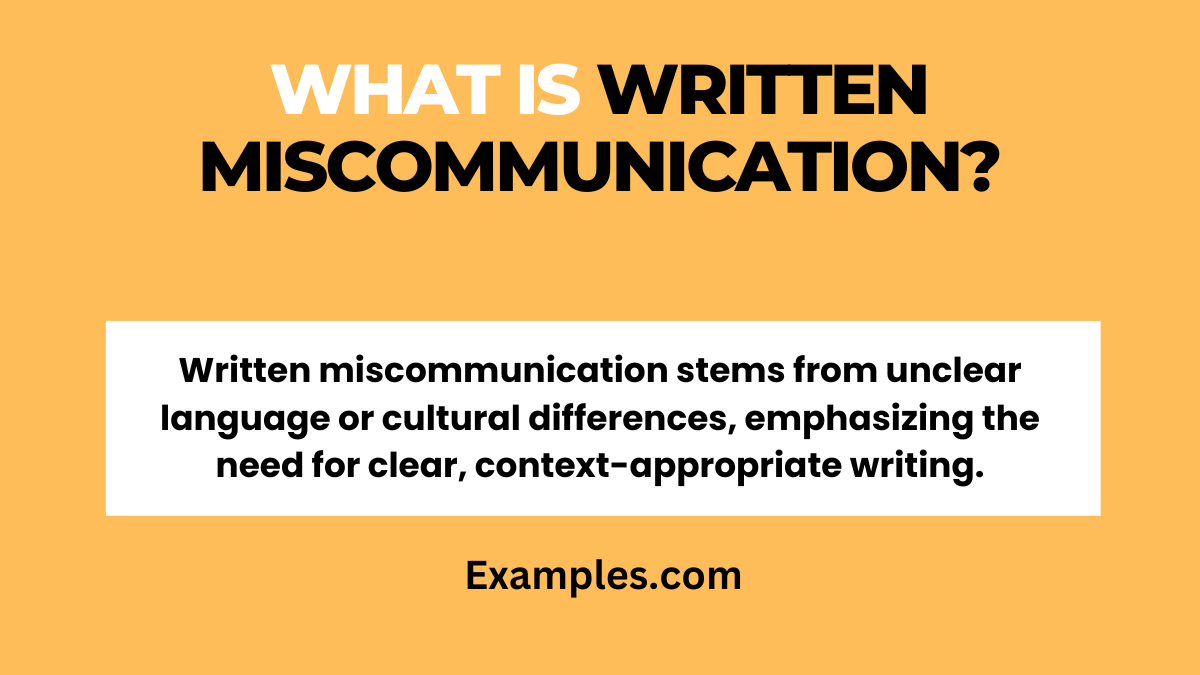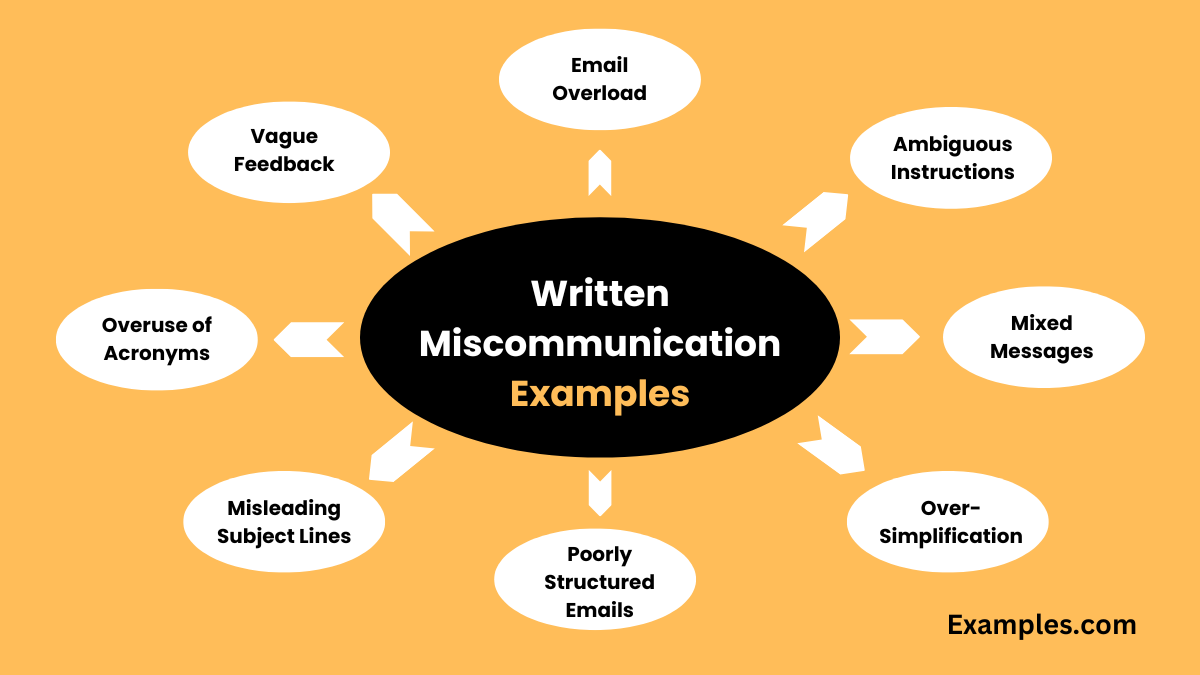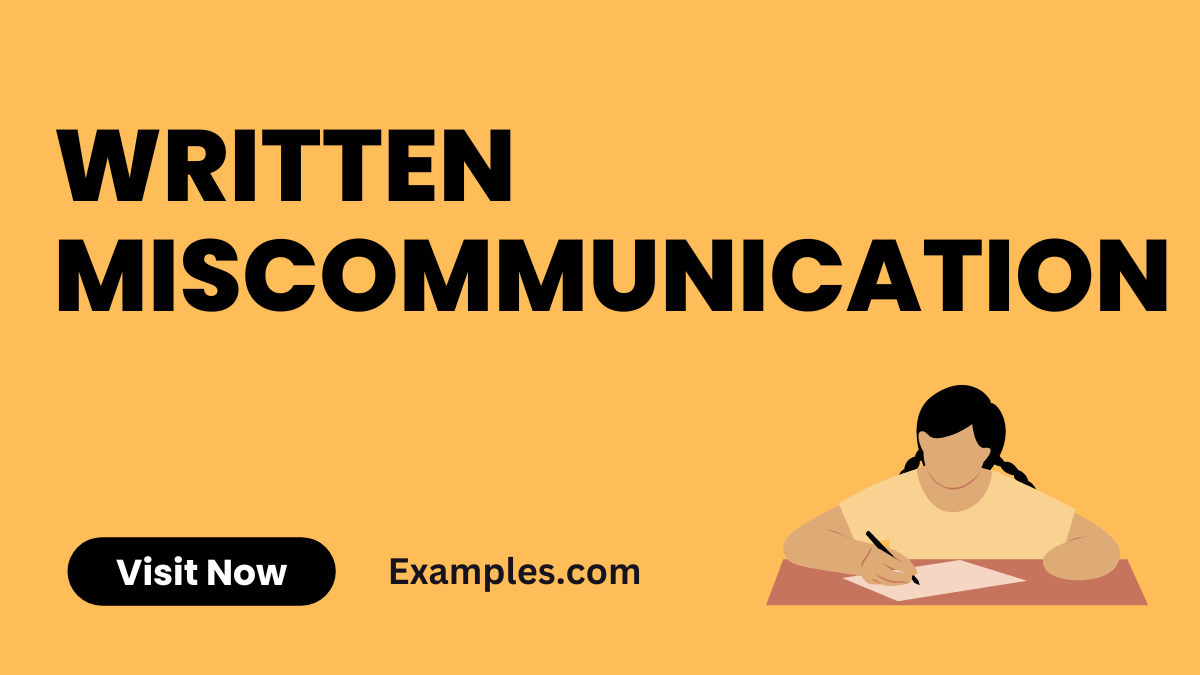19+ Written Miscommunication Examples
Written miscommunication can be a subtle yet significant hurdle in conveying messages accurately. This comprehensive guide, enriched with practical miscommunication examples, delves into the nuances of written communication. It aims to illuminate common pitfalls and provide actionable insights for clearer, more effective written exchanges. From emails to texts, understanding the dynamics of written communication is key to avoiding misunderstandings and ensuring your message is received as intended.
What is Written Miscommunication?

Written miscommunication occurs when the intended message of written words is misunderstood or misinterpreted by the reader. This can happen due to unclear language, lack of context, cultural differences, or simply the absence of non-verbal cues that assist in communication. The key to preventing written miscommunication lies in clear, concise, and contextually appropriate language.
20 Written Miscommunication Examples

- Email Overload: Sending too many emails leads to important details being overlooked.
Communicate effectively: Prioritize and consolidate information in fewer emails. - Ambiguous Instructions: Vague directions in a manual causing confusion.
Communicate effectively: Use clear, step-by-step instructions for better understanding. - Misunderstood Tone in Texts: A joke in a text message taken seriously
Communicate effectively: Indicate humor clearly or avoid it in professional contexts. - Cultural Misinterpretation: A phrase in a business email offending a client from a different culture.
Communicate effectively: Be aware of cultural nuances and tailor your communication accordingly. - Typos Leading to Misunderstanding: A typo changing the meaning of a critical directive.
Communicate effectively: Proofread carefully to avoid misinterpretation. - Overly Technical Language: Specialized jargon in a report confusing the non-specialist reader.
Communicate effectively: Simplify language and explain technical terms. - Lack of Context: A brief email missing essential background information.
Communicate effectively: Provide necessary context for clarity. - Contradictory Messages: Contradicting statements in a document leading to confusion.
Communicate effectively: Ensure consistency in all your written communications. - Imprecise Language in Contracts: Ambiguity in contract terms causing legal disputes.
Communicate effectively: Use precise, unambiguous language in legal documents. - Misinterpreted Humor in Official Documents: An attempt at humor in a formal report being taken offensively.
Communicate effectively: Maintain a professional tone in official documents. - Inadequate Explanation of Changes: Poorly communicated updates in a project plan causing disruption.
Communicate effectively: Clearly explain any changes and their implications. - Incorrect Information: Sharing outdated data in a company memo.
Communicate effectively: Verify information before dissemination. - Assumed Knowledge: Using industry terms without explanation in a public document.
Communicate effectively: Assume no prior knowledge and explain all terms. - Sarcasm Misunderstood in Email: Sarcastic remark in an email taken literally.
Communicate effectively: Avoid sarcasm in written form, as it often misfires. - Vague Feedback: Unclear feedback in a performance review leading to confusion.
Communicate effectively: Provide specific, actionable feedback. - Overuse of Acronyms: Acronyms in a report not understood by all readers.
Communicate effectively: Define acronyms or use plain language. - Misleading Subject Lines: An email subject line not reflecting the email’s content.
Communicate effectively: Use accurate, descriptive subject lines. - Poorly Structured Emails: Disorganized content in an email causing misunderstanding.
Communicate effectively: Structure your emails logically with clear points. - Over-Simplification: Oversimplifying a complex topic leading to misinformation.
Communicate effectively: Balance simplicity with necessary detail. - Mixed Messages: Conflicting instructions in different documents.
Communicate effectively: Align all communications for consistency.
What problems can Written miscommunication cause?
- Loss of Trust: Miscommunications can erode trust between parties, whether in personal or professional relationships.
- Misunderstandings can lead to doubt and skepticism, undermining future interactions.
- Project Delays: In the workplace, unclear instructions can cause significant project setbacks.
- Misinterpretations often result in rework, consuming additional time and resources.
- Increased Costs: Errors in communication can lead to costly mistakes, impacting a company’s bottom line.
- Misguided decisions based on incorrect information can result in financial losses.
- Legal Issues: Ambiguities in written contracts or agreements can lead to legal disputes.
- Misinterpretations in legal documents can result in litigation and penalties.
- Damaged Reputation: Public miscommunications can harm an organization’s image.
- Missteps in public statements or advertising can lead to negative publicity.
- Employee Frustration: Unclear communications can lead to frustration and decreased morale among employees.
- Consistent miscommunication can create a demotivating work environment.
- Customer Dissatisfaction: Misleading or confusing information can frustrate clients and customers.
- Poor communication can result in a loss of trust and business from customers.
Written Miscommunication in the Workplace
- Inaccurate Reporting: Misreported data in business documents leading to incorrect decision-making.
- Accurate and clear reporting is essential for informed business strategies.
- Conflict Among Team Members: Misunderstood emails or messages causing interpersonal conflicts.
- Effective communication is key to maintaining harmony in the workplace.
- Inefficient Task Delegation: Unclear instructions resulting in tasks being performed incorrectly or not at all.
- Clear, concise directives are crucial for efficient task completion.
- Missed Deadlines: Miscommunication about deadlines leading to delayed project completion.
- Ensuring everyone is on the same page regarding timelines is vital.
- Brand Misrepresentation: Inconsistent messaging in marketing materials affecting brand identity.
- Cohesive and clear communication is crucial in representing a brand accurately.
- Security Breaches: Ambiguous guidelines on security protocols leading to vulnerabilities.
- Clear, detailed communication about security policies is essential for safety.
- Poor Customer Service: Miscommunications in customer interactions leading to dissatisfaction.
- Clear and empathetic communication is vital in customer service.
- Stalled Innovation: Misunderstandings in collaborative projects hindering innovation.
- Effective communication is necessary to foster creativity and progress.
- Legal Compliance Issues: Misinterpretations of regulatory requirements leading to non-compliance.
- Precise communication is crucial for adhering to legal standards.
- Wasted Resources: Miscommunication causing unnecessary use of resources.
- Efficient communication helps in optimal resource utilization.
How to Avoid Written Miscommunication?
- Clarity and Brevity: Be clear and concise in your writing to avoid ambiguity.
- Focus on delivering your message as straightforwardly as possible.
- Proofread: Always review your written communication for errors and clarity.
- A second review can catch mistakes that could lead to misunderstandings.
- Use Simple Language: Avoid jargon and complex language that might confuse the reader.
- Using straightforward language ensures your message is understood by all.
- Provide Context: Always include necessary background information.
- Context helps the reader understand the full scope of the message.
- Confirm Understanding: Seek confirmation to ensure your message is understood as intended.
- This can be done through follow-up questions or feedback requests.
- Use Visual Aids: Incorporate charts or diagrams to complement complex information.
- Visuals can help clarify and reinforce written communication.
- Cultural Sensitivity: Be mindful of cultural differences that may impact how your message is received.
- Understanding cultural nuances can prevent misinterpretation.
Miscommunication, particularly in written form, can lead to a myriad of issues ranging from personal Miscommunication in Texting to professional setbacks. By understanding its causes and implementing strategies to avoid it, we can greatly enhance the effectiveness of our communication, leading to more successful interactions and outcomes.



